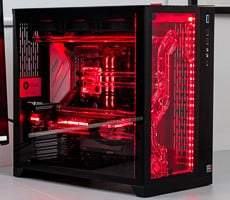The last time we looked at Dell's Alienware X51 series of console-sized gaming PCs was back in mid-2013. Back then we were working with Intel's 4th generation
Haswell Core Series processors and NVIDIA's
GeForce GTX 600 series GPUs based on their Kepler graphics core. Our man Paul, frankly, was spouting off a bit wildly about aliens
serving humans for dinner and, well, let's just say it made for interesting reading. But that was so 2013, and like anything in life, seasons change and architectures evolve. Paul is still nuttier than a fruit cake but that's a different story all together, so we'll just stay on task.
The Alienware team has been relatively quiet for the past 18 - 24 months or so with respect to their X51 small form factor gaming rigs, but Intel's recent
Skylake processor launch and NVIDIA's further optimizations in their
Maxwell GPU architecture have given the company a frenzied salvo of artillery fire power for their tiny but mighty gaming PC product line. To boot, the past few months have brought forth new innovation at the platform chipset level, as well as within the storage space. And so it was fitting that, almost from top to bottom, the Alienware X51 R3 was given a complete overhaul of the lastest technologies, all of which play very well with the tighter power budgets and thermal constraints of this class of machine.
Alienware calls their new machine simply the X51 R3, as it's the third revision of the product -- and here it is, in the flesh.
 #PCMasterRace - Consoles wish they had the chops.
#PCMasterRace - Consoles wish they had the chops.  | | Dell Alienware X51 R3 Small Form Factor Gaming PC | | Specifications & Features |
|
| Processor |
| Intel Core i7 6700K Water-Cooled And Overclocked
|
| Operating System |
| Windows10 Professional
|
| Chipset |
| Intel Z170 Express Chipset
|
| Graphics |
| Intel HD Graphics 530
NVIDIA GeForce GTX 960
|
| Memory |
| 16GB DDR4 2133MHz DRAM |
| Storage |
| Samsung SSD PM951 M.2 256GB PCIe NVMs Solid State Drive
Toshiba 2TB (7200 RPM) SATA 6G Hard Drive
|
| Networking |
| Intel Maple Peak 17265NGW AC WiFi With Bluetooth 4.0
10/100/1000 Ethernet LAN |
Front Panel Ports
|
| 2 x USB 3.0; Headphone and Mic
|
Rear Panel Ports
|
| 4 x USB 3.0; 2 x USB 2.0; GbE LAN; HDMI; 3xDisplayPort, DVI-D Optical S/PDIF; Audio inputs, Graphics Dock
|
| Sound |
| Integrated 7.1 channel surround sound
|
| Power Supply |
| 330W (19.5V, 16.9A)
|
| Dimensions |
| 13.504 (H) x 12.52 (D) x 3.74 (W) inches
|
| Weight |
| 12.1 pounds
|
| Manufacturer Warranty |
| 1-year
|
| Pricing: |
| Starting at $699 -- $1,999 (as configured)
|
The rundown of specs here for the new X51 R3 reads like a veritable menu board of the latest PC technologies, from
Windows 10 to Intel's Skylake
Core i7-6700K processor and companion Z170 motherboard chipset, NVIDIA's GeForce GTX 960, 16GB of DDR4-2133 memory and yes, none other than Samsung's PM951 M.2 PCI Express NVMe Solid State Drive. And to ice the cake further, Alienware dropped in a custom self-contained water cooler that keeps the system quieter under load while affording a modest overclock on the processor to 4.4GHz max Turbo Frequency.
 Dell Alienware X51 R3 With 330 Watt DC Power Brick - Geek Paw For Scale
Dell Alienware X51 R3 With 330 Watt DC Power Brick - Geek Paw For Scale
Even though the internals of the X51 R3 are significantly more powerful than the
previous generation R2 setup we tested, Alienware has managed to keep within the same power envelope and as such the same 330 Watt power brick from the last version was employed again with this new model. In fact, it's about the only component that stayed the same with the X51 R3, save for a few miscellaneous items and its external skins. Cosmetically, the X51 R3 still looks slick, current and well-made versus similar sized systems on the market. It clearly targets enthusiasts with its AlienFX lighting accents while measuring
a little bigger than an Xbox 360, though not quite as big as the Xbox One -- both of which are begging for a beat-down by this feisty little fellow. Let's drop in for a closer look.







